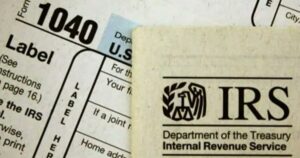This year’s tax refunds are causing a lot of anxiety among taxpayers, who are concerned that their refunds may be smaller than usual. According to preliminary data from the IRS, the fear may be well-founded.
According to figures from February 11, the average return is around $2,300. The average refund was $2,800 last year.

However, there is a caveat to these early statistics because millions of refunds have not yet been issued. Since tax returns must be filed by April 18, the typical refund could alter or possibly increase as the season advances.
According to IRS figures, the government received 169 million individual tax returns in 2021 and issued 129 million refunds. More than 4 million refunds have been granted by the IRS so far this year in 2022.
How long will you have to wait in 2022 to collect your tax refund?
A tax return is generally the biggest check a family receives in a year, and many people use the money to pay off debt, build savings, or just to get by. However, customers are concerned about the size of their returns this year due to growing prices and tax code changes from the epidemic era.
Even though the enhanced Child Tax Credit increased the number of money parents received, only half of it was paid out in monthly installments during the year 2021. This year’s tax returns can claim the remaining $1,500 for older children or $1,800 for younger children.
According to tax experts, that’s less than the $2,000 families claimed on their returns in previous years for the CTC.
According to Ted Rossman, a senior industry analyst at Bankrate, consumers are “worried that their returns may be delayed, they may be lower.” As one taxpayer put it, “We appreciated last year’s early CTC payouts, but it could mean a lesser refund this year.”
According to a Bankrate survey, almost one-third of taxpayers are worried that their return would be lower this year than in previous years.
The Treasury Department warned in January that the tax season will be challenging because the government is still dealing with a backlog of returns from 2021, which may explain why 1 in 4 taxpayers are concerned about their refunds being delayed.
There are a lot of households and families that rely on that refund, especially those on the lower end of the income spectrum, so a smaller refund is clearly a concern,” said Joe Buhrmann, a CFP and senior financial planning expert at eMoney Advisor.
Tax refunds are based on a wide range of criteria, including income, deductions, tax credits, and withholding. Taxpayers should not assume that their individual checks will be reduced because of a lower average refund than in the previous year.
Reasons why reimbursements are less than expected
In addition to the Child Tax Credit, there are a number of other factors that could result in lower returns for some taxpayers this year, Buhrmann says. Student loan repayments have been put on hold due to a federal government freeze.
When it comes to taxes, “the halted student loan repayment has been quite beneficial and the relief was pleasant,” Buhrmann said.
Student loan interest is deductible for tax purposes up to a maximum of $2,500 per taxpayer. But if you don’t pay any interest, you can’t claim that deduction. Deductions reduce an individual’s taxable income, which means that a smaller tax refund could happen if the tax deduction is not taken into consideration.
Those who receive unemployment benefits may not have had taxes withheld from those payments, which means that when they file their taxes, they’ll have to pay up, which might reduce their refunds. Some people who started a new job may have failed to withhold the correct amount of taxes from their income, resulting in an unpleasant tax surprise.
“You get a nasty surprise when you file your taxes if you don’t utilize a withholding calculator provided by your company, Buhrmann said. “The tax code is a little bit of a black box,” he said.
When will I be refunded?
According to the IRS, the majority of taxpayers should receive their refunds within 21 days of completing their taxes. Even yet, the IRS has warned that a tax refund could be delayed due to a few difficulties.
For starters, the IRS is encouraging people to file electronically and request a direct deposit, which will expedite the process. (The time it takes to process paper returns is increased since personnel at the agency must do so by hand.)
Some tax credits, on the other hand, may slow down the procedure. Measures to combat tax fraud may cause delays for those submitting claims for the Child Tax Credit or the Earned Income Tax Credit (EITC). The Internal Revenue Service (IRS) recently said that those who claimed these credits should get their refunds by March 1.
The IRS website has a “Where’s My Refund?” link under the Refunds tab that allows taxpayers to see the current status of their refund. If you’re married and filing as a married couple, you’ll need to know your Social Security number or Individual Taxpayer Identification Number, as well as your refund amount.
When an electronic return has been received by the IRS or a paper return has been mailed in, taxpayers can check the status of their refund within 24 hours or four weeks, respectively. The tool will notify the taxpayer when their return is received, when their refund is approved, and when their refund is sent, informing them at each stage of the processing procedure.
For the month of February
According to Bankrate, the majority of taxpayers (44 percent) expect to file their returns in February. Another 25% said they’ll file in March, while a further 16% said they’ll hold off until April to file their taxes. After the April 18 deadline, the remaining taxpayers surveyed by Bankrate either didn’t know when they would file or planned to do so after that time.
Nearly one-third of taxpayers are concerned that their refunds won’t go as far this year because of rising inflation, according to Bankrate. The price of everything from groceries to gas is rising faster than it has in the previous 40 years.
As a result of Russia’s invasion on Ukraine, experts believe that the price of petrol and other commodities in the United States would rise even further.
Middle-class families are bearing the brunt of rising expenditures, according to a recent study from Wells Fargo. This is due to the fact that middle-class families are more likely to purchase recently-revealed used cars, despite the fact that new car prices have climbed considerably.
In addition, the study indicated that middle-class consumers spend more money on gasoline than those in the lower-income brackets.
When it comes to the cost of food, “many have been touched by growing inflation,” Buhrmann added. “If the return is lesser, or you don’t withhold enough, it will sting a little bit.”




